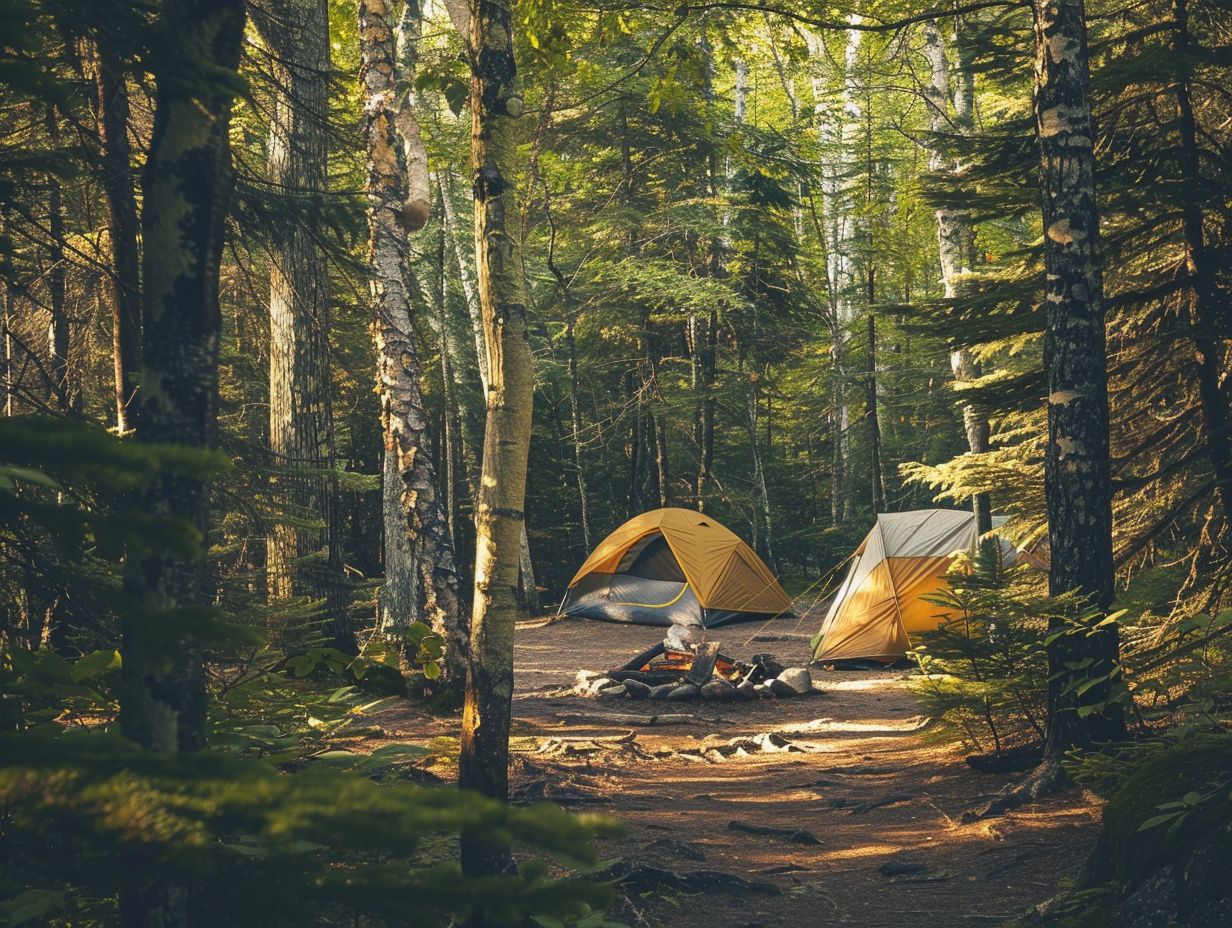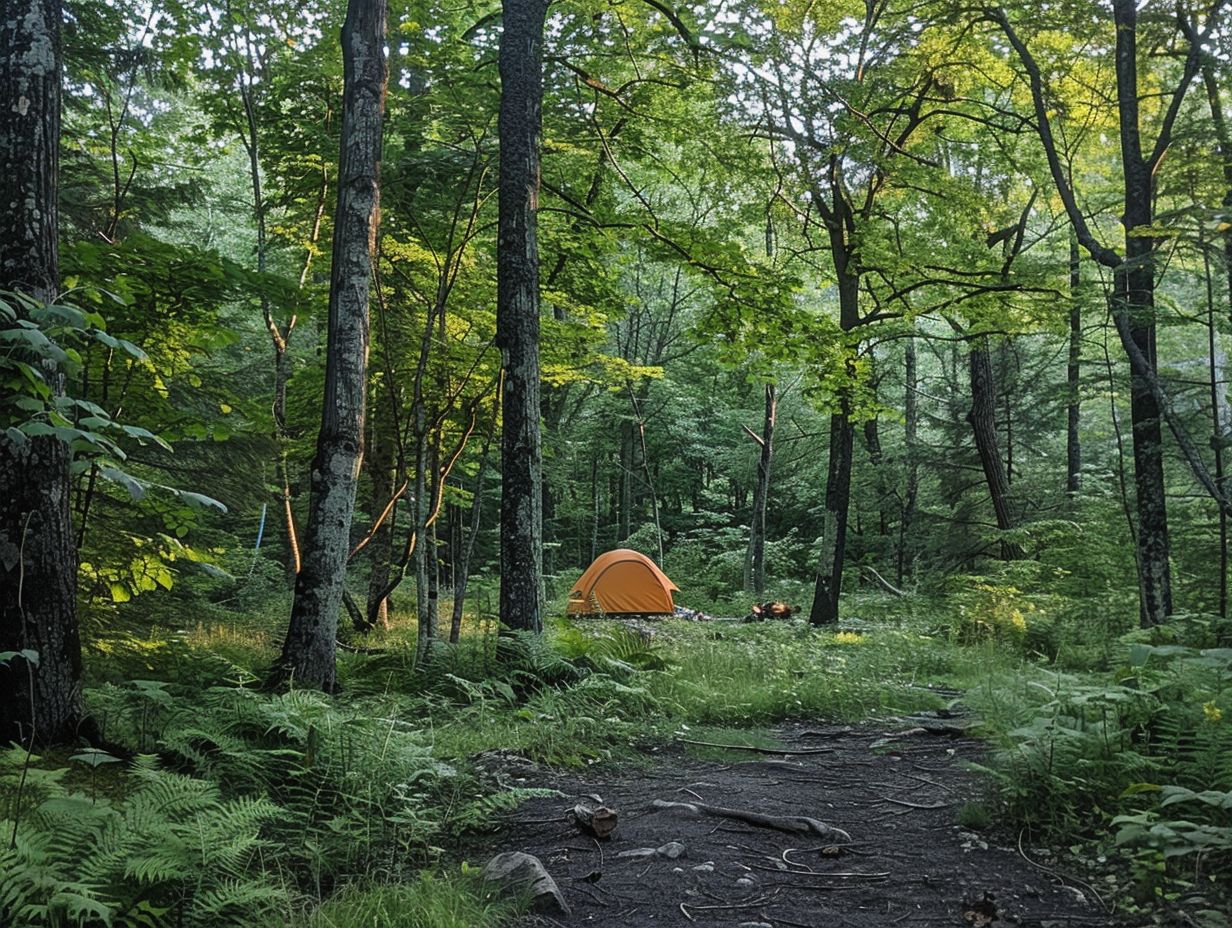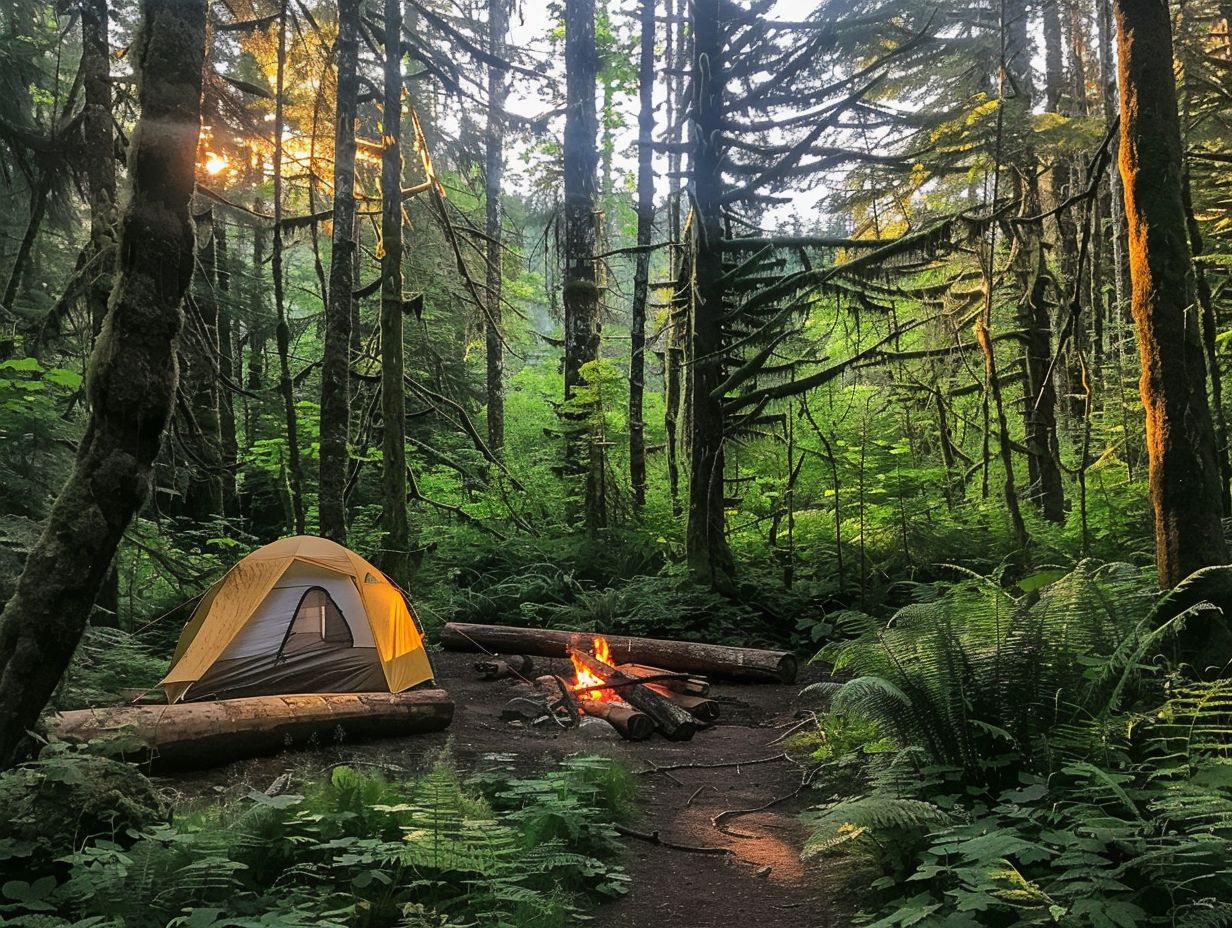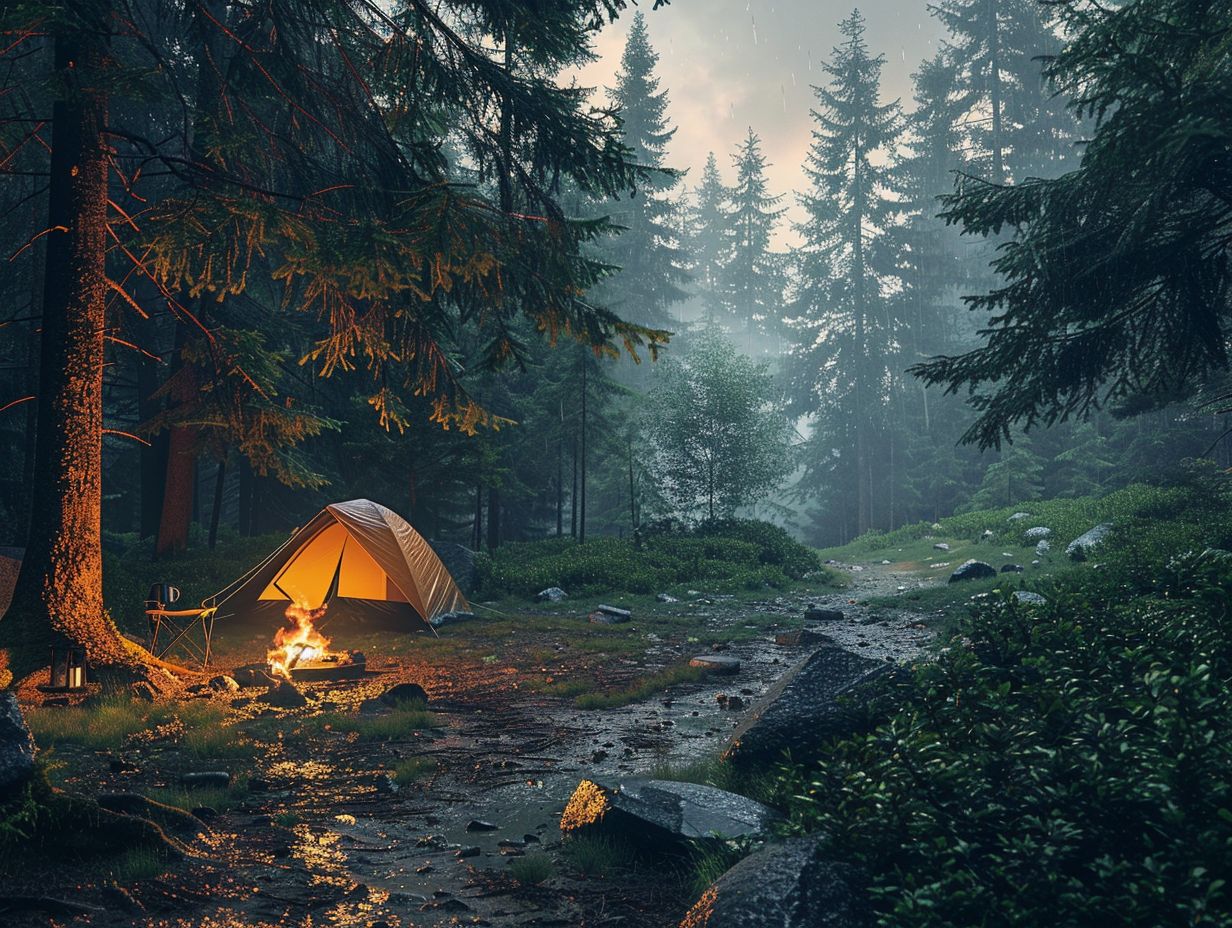When camping near wildlife reserves, you have a special chance to immerse yourself in nature, but you also have a duty to safeguard the environment and its inhabitants.
It’s important to familiarise yourself with key tips for camping near wildlife reserves, such as conducting research on the local wildlife, adhering to campground regulations, and showing respect for the habitat.
Educate yourself on typical errors to steer clear of, safety measures to implement when camping near hazardous wildlife, and ways to advocate for responsible and sustainable camping practices.
Find out how you can contribute to environmental conservation while relishing the splendour of wildlife reserves.
Key Takeaways:

- Do your research on the local wildlife before camping near a reserve.
- Always follow campground rules and regulations to ensure the safety of both yourself and the animals.
- Keep a safe distance from wildlife, do not approach or feed them to avoid potential conflicts.
1. Research the Wildlife in the Area
Before camping in the vicinity of Yellowstone National Park, Glacier National Park, or Yosemite National Park, it is essential to research the wildlife species inhabiting the area to ensure a safe and enriching experience.
Understanding the wildlife present in these parks can not only enhance your camping adventure but also help you make informed decisions to protect both yourself and the animals.
By familiarising yourself with common species, their behaviours, and how to safely interact with them, you can prevent potential encounters that may pose risks to either party.
Resources such as park websites and visitor centres offer valuable information on the diverse wildlife that call these parks home, allowing you to appreciate nature while minimising any negative impacts on the ecosystem.
2. Follow Campground Rules and Regulations
Adhering to the established campsite rules and regulations within NPS sites like Yellowstone National Park, Grand Canyon National Park, or Joshua Tree National Park is essential for maintaining safety and preserving the natural environment.
By following these regulations, you contribute to the overall harmony and sustainability of these treasured outdoor spaces.
Proper pitch selection, respecting quiet hours, responsible waste disposal, and adherence to fire safety measures are key aspects governed by these rules.
For example, NPS mandates designated camping areas to prevent environmental damage, enforces quiet hours between 10 pm to 6 am to ensure peace for all visitors, requires taking away all rubbish to minimise impact, and prohibits unattended campfires to prevent wilderness fires. These regulations not only protect the parks but also enhance the camping experience for everyone.
3. Keep a Safe Distance from Wildlife
When encountering wildlife in locations such as Yellowstone, Yosemite, or Zion National Park, it is imperative that you maintain a safe distance to protect both yourself and the animals in their natural habitat.
Approaching too closely can not only stress the animals but also pose serious risks to your own safety. By keeping a respectful distance, you allow the animals to behave naturally without feeling threatened.
Wildlife viewing etiquette emphasises the importance of observing quietly and unobtrusively. Disturbing animals can lead to aggressive behaviour or the animals fleeing their habitat, disrupting their necessary activities for survival. Remember, these creatures are wild and should be admired from afar to ensure their well-being and your own.
4. Do Not Feed or Approach Wild Animals
Avoid feeding or approaching wild animals in Grand Teton National Park, Great Smoky Mountains National Park, or Acadia National Park to prevent habituation and ensure the animals’ well-being and your safety.
Wildlife that is fed by humans can lose their natural wariness towards humans, becoming reliant on handouts, which can lead to aggressive behaviour. Feeding wildlife can disrupt their natural diet, making them more susceptible to illness.
To enjoy and appreciate wildlife in their natural habitat, consider using binoculars or spotting scopes to observe them from a safe distance. This not only keeps both you and the animals safe but also preserves the wildness and integrity of these precious ecosystems.
5. Properly Store Food and Trash
Ensuring proper storage of food and rubbish while camping near Yellowstone National Park, Glacier National Park, or Grand Canyon National Park is crucial in preventing wildlife attraction and maintaining campground cleanliness.
Using bear-proof containers and designated bins for waste disposal is a recommended practice in these areas to protect both campers and wildlife.
By securely storing food items in airtight containers and promptly disposing of any rubbish in the designated bins, you can significantly reduce the likelihood of encountering unwanted animal intruders.
These proactive measures not only aid in preserving the natural habitat but also contribute to a safer and more enjoyable camping experience for all.
6. Be Mindful of Your Noise Level
In tranquil environments such as Olympic National Park, Acadia National Park, or Zion National Park, it is crucial for you to be mindful of your noise level while camping. This is necessary to show respect for the natural tranquillity of the surroundings and to avoid disturbing the wildlife in the area.
Excessive noise can have a significant impact on wildlife behaviour as it disrupts their natural habitat and communication signals. Animals such as birds, mammals, and insects rely on sound cues for activities like mating, hunting, and survival, and loud noises can interfere with these essential behaviours.
Additionally, noise pollution can greatly affect the overall camping experience, impeding relaxation and the enjoyment of the peaceful environment.
To ensure a quiet campsite, it is recommended that campers take simple steps such as using quiet camping equipment, speaking softly, and refraining from unnecessary loud noises especially after dark.
Opting for designated camping areas located away from high-traffic zones can help reduce disruptive sounds and protect the natural soundscape of the area.
7. Avoid Using Strong Scents

When camping in fragrant landscapes like Joshua Tree National Park, Grand Canyon National Park, or Great Smoky Mountains National Park, it is advisable to avoid strong scents in order to prevent attracting wildlife and maintaining the natural ambience.
Strong scents have the potential to disrupt the natural behaviours of animals, prompting them to approach campsites in search of food or out of curiosity.
This can create safety risks for both the wildlife and campers. To mitigate these risks, campers should consider using scent-free personal care products such as unscented soaps, shampoos, and lotions.
Properly storing all scented items in bear-resistant containers can help minimise the likelihood of wildlife encounters. Prioritising the preservation of the wilderness by practising scent-free camping is essential to ensure the safety of all beings involved.
8. Keep Your Pets on a Lead
When exploring pet-friendly areas in Yellowstone National Park, Glacier National Park, or Zion National Park, it is crucial to keep your pets on a lead. This practice ensures their safety, protects wildlife, and shows consideration for other visitors.
Using a lead serves multiple purposes. It prevents pets from getting lost or injured in unfamiliar terrain and plays a vital role in preserving the natural habitat of the parks. Unrestrained pets can easily disturb wildlife, leading to negative impacts on their behaviour and habitats.
Responsible pet ownership while camping requires mindfulness of the environment and wildlife in your surroundings. Adhering to lead regulations is essential for pet owners to contribute to maintaining a balance between enjoying nature and conserving it for future generations.
9. Be Prepared for Emergencies
Before embarking on a camping trip to Grand Teton National Park, Great Smoky Mountains National Park, or Olympic National Park, ensure you are well-prepared for emergencies with appropriate equipment, first aid supplies, and knowledge of safety protocols.
One of the most crucial aspects of emergency preparedness while camping is to have a fully stocked first aid kit. Make sure your kit includes items like plasters, antiseptic wipes, painkillers, and any prescription medicines you may need.
Plus the first aid kit, it is important to bring communication devices such as a fully charged mobile phone, a portable charger, and possibly a two-way radio in case of emergencies. Knowing your emergency contact information by heart or having it written down in a safe place can be invaluable during stressful situations while camping.
10. Respect the Habitat
When you are camping near habitats such as Okefenokee National Wildlife Refuge, Grand Canyon National Park, or Glacier National Park, it is imperative to show respect for the natural environment, follow Leave No Trace principles, and contribute to conservation initiatives.
To maintain the delicate balance of these protected areas, it is essential for campers to minimise their impact through sustainable camping practices. This includes utilising designated campsites, carrying out all rubbish, and refraining from activities that could disturb wildlife.
Adherence to fire restrictions, the use of biodegradable products, and the conservation of water are crucial steps in reducing the ecological footprint left in these areas. Responsible camping practices not only protect the biodiversity of these regions but also ensure that the beauty of these natural landscapes can be enjoyed by future generations.
11. Do Not Disturb Nesting Areas
Protecting nesting areas in sensitive habitats such as Yosemite National Park, Yellowstone National Park, or Great Smoky Mountains National Park is crucial to ensuring the well-being of wildlife populations and supporting conservation initiatives.
Nesting areas are vital spaces where numerous species seek shelter, reproduce, and care for their young. These habitats play a pivotal role in upholding biodiversity and sustaining ecosystems.
For example, in Yosemite National Park, the peregrine falcon depends on the park’s cliffs as nesting sites. Similarly, Yellowstone National Park is a habitat for grizzly bears that require undisturbed areas for raising their offspring.
Preserving these nesting areas is imperative to enable these species to flourish and maintain their contributions to the overall ecological equilibrium.
12. Leave No Trace
Practising Leave No Trace principles while camping in pristine locations such as Grand Teton National Park, Joshua Tree National Park, or Acadia National Park is crucial to minimising environmental impact and preserving the natural beauty for future generations. These principles act as a roadmap for outdoor enthusiasts to responsibly enjoy nature.
The first principle emphasises the importance of planning ahead and being prepared. This includes having the appropriate gear, a thorough understanding of the area, and full compliance with regulations. Campers must prioritise camping in designated areas to prevent any harm to delicate ecosystems.
Adhering to the ‘Dispose of Waste Properly’ principle involves maintaining cleanliness at campsites and leaving them in the original condition. The ‘Leave What You Find’ principle encourages leaving natural elements like rocks, plants, and other artefacts undisturbed.
Respecting wildlife and minimising disruptions align with the ‘Respect Wildlife’ principle. It is essential for campers to be mindful of other visitors to ensure a positive outdoor experience for all individuals involved.
13.Be Aware of Seasonal Changes and Migrations
Understanding seasonal changes and wildlife migrations in areas like Great Smoky Mountains National Park, Olympic National Park, or Glacier National Park is crucial for planning camping trips, observing natural phenomena, and respecting animal movements.
Each national park has its unique charm based on the time of year you visit. For example, the Great Smoky Mountains National Park is renowned for its synchronous fireflies in late spring, while the autumnal foliage in Olympic National Park is a sight to behold.
Understanding these seasonal variations not only enhances your experience but also allows you to witness rare wildlife behaviours, such as elk rutting in autumn or bear sightings during hibernation preparations. Timing your visit based on these natural cycles can provide unforgettable encounters with nature.
14. Know How to React in Case of an Encounter

Being prepared to react appropriately in the event of a wildlife encounter while camping in Yosemite National Park, Grand Canyon National Park, or Glacier National Park is essential for ensuring personal safety and minimising conflicts with animals.
When encountering bears, it is important for you to remain calm, avoid direct eye contact, and speak in a calm, firm voice to communicate that you are human and not prey. Slowly back away without turning your back, as sudden movements can provoke an aggressive response.
In the case of encounters with mountain lions, it is recommended that you maintain eye contact, make yourself appear larger by raising your arms, and assert dominance by speaking loudly.
To deter coyotes, you should make loud noises, wave your arms, and throw objects to scare them away. It is always advisable to research specific wildlife encounters for the park you are visiting and adhere to the recommended protocols.
15. Report Any Violations or Concerns
If you notice any violations or have safety concerns whilst camping in Yellowstone National Park, Zion National Park, or Grand Teton National Park, it is important to promptly report them to park authorities to maintain a safe and enjoyable environment for all visitors.
By reporting violations, you contribute to the preservation of these natural wonders and the safety of fellow campers. Timely reporting ensures that park regulations are upheld and any potential hazards are addressed swiftly.
In case of emergencies or urgent situations, visitors can contact the park offices directly or utilise emergency services by referring to the official park maps or information kiosks.
Your vigilance and cooperation play a crucial role in ensuring that everyone can experience these national parks safely and responsibly.
How Can Camping Near Wildlife Reserves Benefit the Environment?
Camping near wildlife reserves such as Yosemite National Park, Glacier National Park, or Okefenokee National Wildlife Refuge can yield positive environmental outcomes. This includes cultivating a deeper appreciation for nature, supporting conservation endeavours, and advancing sustainable tourism practices that aid in habitat preservation and wildlife safeguarding.
When you immerse yourself in the natural surroundings of these reserves, you tend to establish a stronger connection to the ecosystems and wildlife that dwell within them.
This firsthand exposure enables campers to witness the significance of conserving these areas for the well-being of future generations. These camping trips offer opportunities for learning and raising awareness about the intricate balance of nature and the necessity for responsible stewardship.
Interacting with the environment in this manner can spark a desire to actively engage in conservation activities. This may involve taking part in volunteer work, making donations, or advocating for initiatives that protect ecosystems.
What Are the Dos and Don’ts When Camping Near Wildlife Reserves?
Understanding the dos and don’ts when camping near wildlife reserves such as Yellowstone National Park, Grand Canyon National Park, or Glacier National Park is crucial for ensuring a harmonious coexistence with nature, minimising human-wildlife conflicts, and preserving the integrity of the natural surroundings.
When you are camping near these protected areas, it is essential to remember not to leave food or rubbish unattended, as it can attract wildlife and potentially lead to dangerous encounters. Always store food securely and dispose of waste properly to prevent animals from becoming habituated to human food sources.
Maintaining a safe distance from wildlife is vital for their well-being and your safety. Observing animals from afar with binoculars or a camera is preferable to approaching them closely. Respect any park guidelines regarding wildlife viewing and photography to avoid disturbing the animals’ natural behavior.
What Are the Common Mistakes to Avoid When Camping Near Wildlife Reserves?
Identifying and avoiding common mistakes when camping near wildlife reserves such as Grand Teton National Park, Acadia National Park, or Joshua Tree National Park is essential for protecting your safety, respecting the environment, and minimising negative impacts on wildlife populations and their habitats.
Campers often make the mistake of improper waste disposal, which can attract unwanted wildlife and disrupt the delicate ecosystem.
Another prevalent error is wildlife feeding, which can lead to dependency on human food and alter natural behaviors. Habitat disturbance through setting up camps in restricted areas or removing vegetation also poses a significant threat to the wildlife and their homes.
To rectify these errors, you should follow Leave No Trace principles, pack out all rubbish, refrain from feeding wildlife, and adhere to designated camping areas to minimise impact and preserve the natural beauty of these reserves.
What Are the Precautions to Take When Camping Near Dangerous Wildlife?
When camping near dangerous wildlife in locations such as Great Smoky Mountains National Park, Zion National Park, or Grand Teton National Park, it is crucial to take necessary precautions to safeguard your well-being, understand potential risks, and prevent wildlife-related incidents during your outdoor adventures.
By being aware of your surroundings and refraining from leaving food or rubbish unattended, you can significantly decrease the likelihood of attracting wildlife to your camping area.
It is important to familiarize yourself with the types of wildlife in the area and their behaviors to anticipate and respond appropriately to any encounters.
If you happen to spot wildlife, it is advisable to remain composed, slowly move away, and avoid sudden movements that might agitate the animal. Always have an emergency communication plan in place and know how to contact park authorities or emergency services if the need arises.
Frequently Asked Questions

What are some important tips to keep in mind when camping near wildlife reserves?
1. Always research the specific wildlife reserve you will be camping near and familiarise yourself with the rules and regulations in place to ensure the safety of both yourself and the animals.
2. Make sure to properly store all food and scented items in airtight containers or bear-proof containers to avoid attracting animals to your campsite.
3. Respect the natural habitat and do not approach or disturb any wildlife. Keep a safe distance and use binoculars or a camera instead.
4. Bring appropriate gear, such as bear spray or noise makers, in case of any unexpected encounters with wildlife.
5. Be cautious and aware of your surroundings at all times, especially at night when animals may be more active.
6. Leave no trace – always clean up your campsite and properly dispose of any waste to avoid attracting animals and disturbing their natural habitat.
Is it safe to camp near wildlife reserves?
Camping near wildlife reserves can be safe as long as you take proper precautions and follow all rules and regulations in place. It is important to always be aware of your surroundings and respect the natural habitat of the animals.
How can I avoid attracting animals to my campsite?
To avoid attracting animals to your campsite, make sure to properly store all food and scented items in airtight containers or bear-proof containers. Avoid cooking or eating in or near your tent, and always clean up your campsite after meals.
What should I do if I encounter wildlife while camping near a reserve?
If you encounter wildlife while camping near a reserve, stay calm and slowly back away. Do not approach or try to feed the animal. If necessary, use bear spray or noise makers to deter the animal and always report any encounters to the proper authorities.
Are there any specific rules for camping near wildlife reserves?
Yes, each wildlife reserve may have specific rules and regulations in place for camping. Some may require permits or have designated camping areas. It is important to research and follow these rules to ensure safety for both yourself and the animals.
What should I do in case of an emergency while camping near a wildlife reserve?
In case of an emergency, contact the nearest park ranger or call 999. It is also important to have a first aid kit and other emergency supplies on hand while camping. Always have a plan in place and make sure to inform someone of your trip itinerary before heading out.



